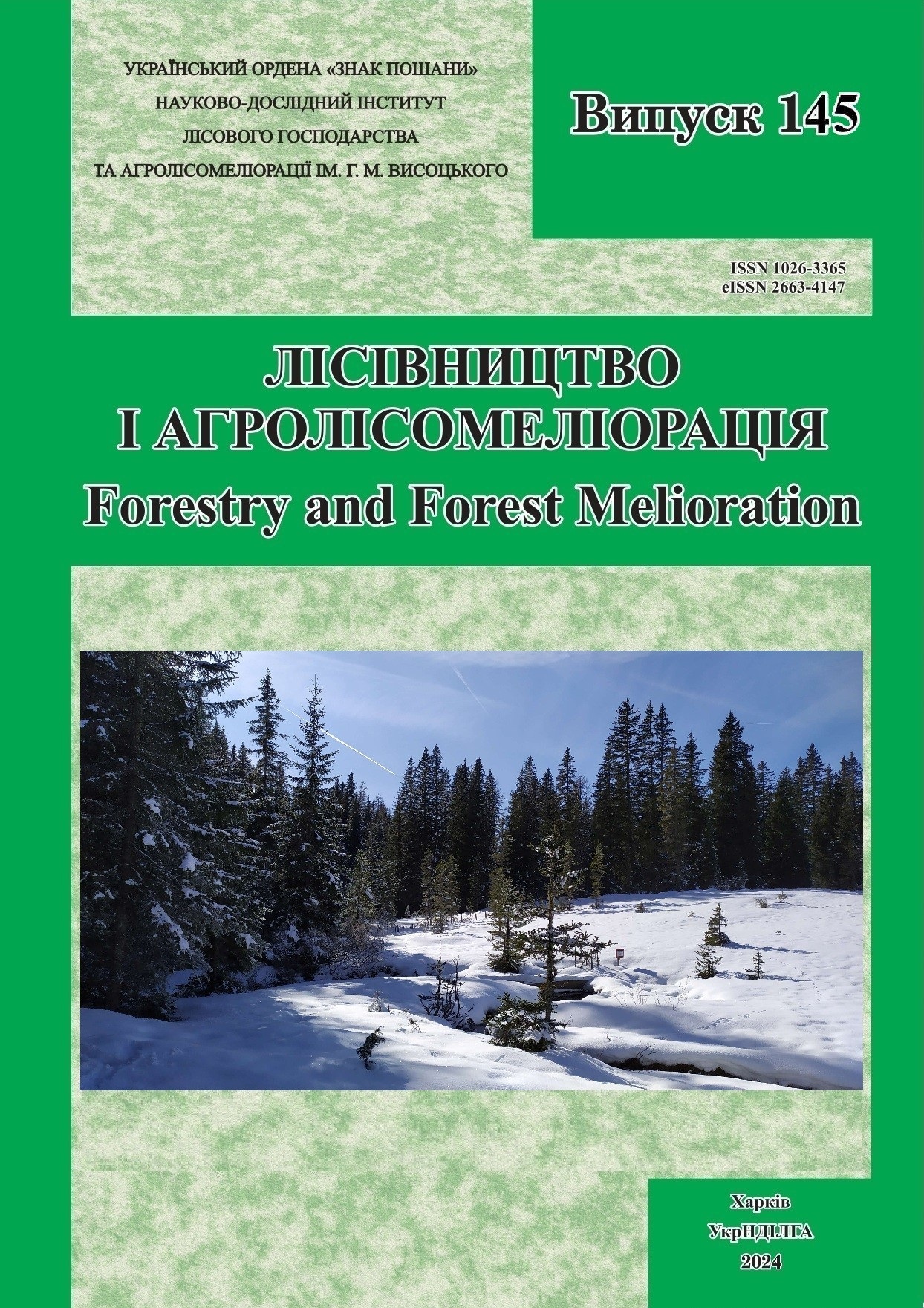Abstract
Introduction
The optimal age distribution of forest stands, their alignment with forest types, and appropriate maturity ages are crucial for sustainable forest management. Analysing the dynamics of forest fund indicators and forest evaluation metrics over different periods is essential for understanding the current state and long-term trends in forest development. This study examines the temporal changes in these indicators for the Branch “Zmiivske Forestry” from 1970 to 2021.
The research aimed to characterise the structural and dynamic changes in forests within the State Specialized Forest Enterprise “Forests of Ukraine”, the Branch “Zmiivske Forestry”, located in Kharkiv region, Ukraine.
Materials and Methods
To assess forest stand characteristics, we utilized the “Forest Fund” database for the Branch “Zmiivske Forestry” as of 01.01.2022, along with forest fund accounting data from 1970, 1980, 1990, 2000, and 2010. The optimal distribution of forested areas by age groups was determined based on established maturity age, considering forest categories and the need for balanced stand distribution across age classes. Additionally, the potential average growing stock per hectare was evaluated to assess the degree of utilisation of forest vegetation capacity. Data from forest typological profiles and sample plots were also incorporated into the analysis.
Results
As of January 1, 2022, the total land area of the forest fund in the Branch was 35.7 thousand hectares, with 96.4% classified as forested land. The forests exhibit significant typological diversity, driven by geomorphological and edaphic variations in forest habitats. Over 65% of the forests are located in rich forest site conditions. Stands of the two main forest-forming species – Scots pine (Pinus sylvestris) and English oak (Quercus robur) – dominate, which are well suited for forestry purposes.
Forests of site class II (53.4%) and site classes I and above site classes (30.7%) are predominant, with an average site class of II.1.
Since 2000, a decline in forested land and an increase in non-forested areas have been observed. The area covered by Scots pine and English oak stands has decreased since 1990, while the presence of common ash (Fraxinus excelsior) and black locust (Robinia pseudoacacia) has expanded. Additionally, a continuous decline in the overall average relative density of stocking has been recorded across all assessment periods, decreasing from 0.74 to 0.66. The distribution of stands by age deviates significantly from the optimal structure. The proportion of forests under protection, where final felling is restricted, has increased, leading to stand aging and an imbalance in the age distribution. Consequently, the proportion of mature and overmature stands has gradually increased from 1.6% in 1990 to 15.9% in 2021.
The health condition of living trees in most sample plots was generally good, although in some plots it was weak. In aspen and black alder stands, a significant proportion of trees were dead or damaged, primarily due to rot.
Conclusions
Our analysis revealed distinct trends in forest fund dynamics, with both positive and negative ecological and economic implications. Notably, non-forested areas are expanding, tree species composition is shifting, and stand aging is leading to reduced productivity and a decline in forest vegetation capacity utilisation. Scots pine and aspen (Populus tremula) stands exhibit the lowest levels of vegetation capacity utilisation, at 52.5% and 52.7%, respectively. Furthermore, due to the ongoing aggression of the Russian Federation, the condition of forests has deteriorated, with some areas sustaining damage from shelling and wildfires.
7 Tables, 16 Refs.
References
Bilous, A.M., Kashpor, S.M., Myroniuk, V.V., Svinchuk, V.A. and Lesnik, O.M. (2021) Forest inventory handbook. Kyiv: Vinichenko Publishing House. ISBN 978-966-981-403-6 (in Ukrainian).
Buksha, M.I., Yarotskiy, V., and Yarotska, M. (2010) ‘Characteristics of forest vegetation of the National Park “Gomolsha forests” as a result of sample statistical forest inventory’, Forestry and Forest Melioration, 117, pp. 40–48 (in Ukrainian).
Forest inventory sample plots. Establishing method. Corporate standard 02.02-37-476:2006. (2007). Valid from May 1, 2007. Kyiv: Ministry of Agrarian Policy of Ukraine (in Ukrainian).
Gensiruk, S.A. (2002) Forests of Ukraine. Lviv: Shevchenko Scientific Society Publishing House (in Ukrainian).
Girs, O.A., Novak, B.I. and Kashpor, S.M. (2013) Forest management. Kyiv: Fitosotsiotsentr (in Ukrainian)
Hrom, M.M. (2010) Forest mensuration. Lviv: RVV UNFU (in Ukrainian).
Nazarenko, V.V. (2016) ‘Study of state and dynamics of forest fund of Kharkiv region on the example of Gutyanske Forestry’, Scientific Bulletin of UNFU, 26.3, pp. 145–150 (in Ukrainian).
Nazarenko, V.V., Garmash, A.V., Buhaiov, S.M., Pasternak, V.P. and Pyvovar, T.S. (2021) ‘State and dynamics of forest fund indicators in SE “Skrypaivske Educational and Research Forestry” (Forest-Steppe, Ukraine)’, Ukrainian Journal of Ecology, 11 (8), pp. 71–78.
Nazarenko, V.V. and Pasternak, V.P. (2016) Patterns of formation of forest types of Forest-steppe of the Kharkiv region. Kharkiv: Planeta-Print. ISBN 978-617-7229-27-7 (in Ukrainian).
Nazarenko, V.V., Pasternak, V.P. and Sklyarov, V.O. (2018) ‘State and dynamic of forest fund SE “Zmiyv Forestry”’, The Bulletin of Kharkiv National Agrarian University. Series: Soil science, agricultural chemistry, agriculture, forestry, and soil ecology, 1–2, pp. 130–137 (in Ukrainian).
Ostapenko, B.F. and Tkach, V.P. (2002) Forest typology. Kharkiv: KhDAU (in Ukrainian).
Project of organization and development of forest management of branch “Zmiyv Forestry”. (2022). Pokotylivka (in Ukrainian).
Sanitary Forests Regulations in Ukraine. (2016). Resolution of the Cabinet of Ministers of Ukraine No. 756 dated 26 October 2016. Available at: https://zakon.rada.gov.ua/laws/show/555-95-п (Accessed 02 February 2023) (in Ukrainian).
Tkach, V.P., Buksha, I.F. and Vedmid, M.M. (2013) ‘Actual problems of forestry development in Kharkiv region’, Forestry and Forest Melioration, 122, pp. 3–11 (in Ukrainian).
Tkach, V.P., Kobets, O.V. and Rumiantsev, M.Н. (2018) ‘Use of forest site capacity by forests of Ukraine’, Forestry and Forest Melioration, 132, pp. 3–12 (in Ukrainian). https://doi.org/10.33220/1026-3365.132.2018.3
Udovychenko, V. (2016) ‘Landscape-typological structure of the forest-steppe complexes of the Left Bank the Dnipro River of Ukraine territory’, Scientific Notes of Ternopil National Pedagogical University. Series: Geography, 1(40), pp. 50–58 (in Ukrainian).

This work is licensed under a Creative Commons Attribution 4.0 International License.

